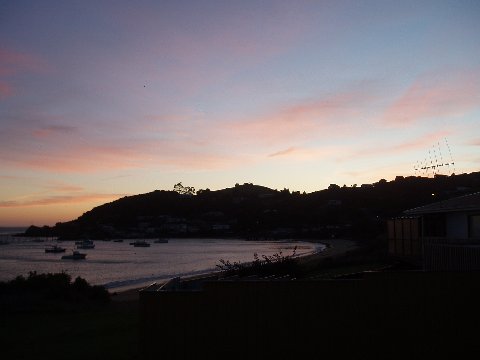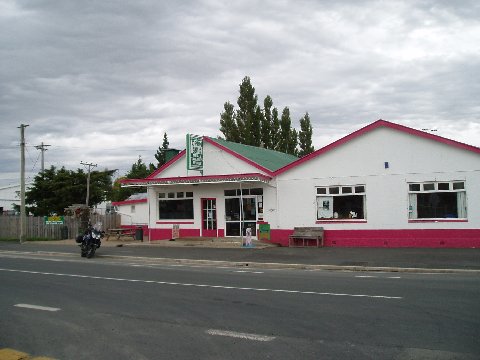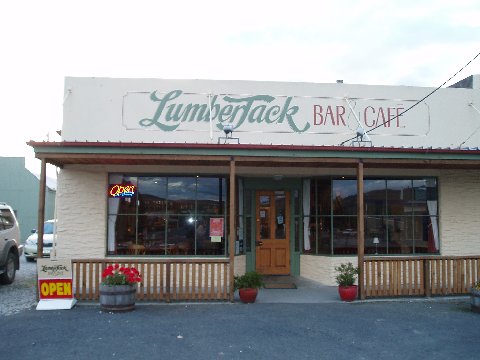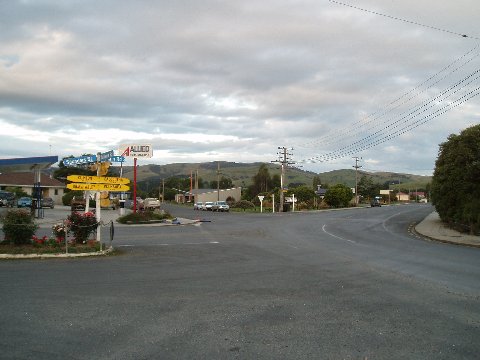Headed south, circle completed
On March 25th, Wednesday morning. I went for a walk from our little beach side cottage up through the village along the road back toward the point. In the dark I could see the lights of the fishing boats going out into the bay. Just as the sun was first beginning to make its light visible I got to the end of the point by Fleur’s restaurant and the beginning of the Millennium Trail.

(the sun comes up over Moreraki Point)
This is a walk way which goes around the edge of the point beyond the village. The path winds along the edge of the cliff at the bottom and continues climbing in a series of switchback paths and steps to the top.

(the steps keep going up and up)
I took some detours out on to points of land that jutted out in the bay. I was standing on one of those perhaps about 300 feet above the ocean as the first red rim of the sun peaked above the Pacific.

(I was standing out on this point when the sun came up)
From that point it seemed to rise rather quickly as light filled the sky and it illuminated my path. I climbed on to the top encountering several sheep on the way who seemed mildly curious about my presence. As I got near one group of three they seemed suddenly to just step off the edge into space but in fact they had just gone over a ledge onto a slope that was at least 60 degrees or more. It seemed not to phase them in the least. Finally I got to the top and the Whaler’s Memorial, the monument which commemorates the ancient sailors who stood up here, spyglass at the ready, waiting for the telltale spout of a whale in the distance. From this highest point one can see an arc of about 300 degrees of ocean and all of the village of Moreaki. Since I don’t think the ancient ones had cell phones, I hope they had some communication system to get the word back to the village, By the time they walked back down the hill, the whale would have been in Samoa.
I made my way back down the hill and circled Fleur’s with the camera taking pictures of where we had been the night before. Back at the cabin we packed up our things and backtracked to Moreraki point, the only place where breakfast was available for miles. We were eating there as yet more tour buses pulled in to disgorge their hordes of camera-toting tourists, each looking for the nearest bathroom. I much prefer our way of travel.
From there we headed south again on route 1 going in and out of Pacific views. From Moreraki down to Palmerston where we left route 1 to head into the mountains, the road skirts along the edge of the pacific with again no development visible to the naked eye. It really is like stepping back in time.
At Palmerston we got fuel and headed up into the mountains going northwest into central Otago. We followed ridge lines through the soft brown hills, actually mountains, on sweeping curves that would come around the edge of one hill and open up into a huge valley below with such dramatic change that it’s disorienting for a moment. There are mostly sheep farms here though quite a few cattle as well. The streams in the valley floors are wide and flat with crushed rock sides, again the handiwork of some ancient glacier. The changes in color were subtle but impressive. The browns and greens shaded into each other and just when one got used to the pattern, another curve would reveal something quite different in a rock formation or another valley. We stopped at a little town of Middlemarch which is what passes for a hub in this area. I’m guessing that the town may have had a population around 500. The central Otago rails to trail system is located here and we could see some of the converted railroad track down in the valley. We met some bicyclists as we stopped to look around for a café and they told us there wasn’t one (we found out later that they just hadn’t gone far enough in to town yet) so we went in to the little general store/deli on the corner. The young man running the place was from Seattle, having married a New Zealand girl who didn’t want to live anywhere else. He had a BMW R-80 back in the states and was very interested in the V-Strom as an alternative. I told him I had no complaints about the bike, but he was concerned, being used to Bavarian boxer simplicity, that the valve adjustment ritual would be too difficult. I suggested that a modern bike like this should be treated like a car, just taken to the dealer once a year for service, then forgotten about (except for the chain of course!) until the next time. Even though this was only a small grocery, nonetheless he had quite adequate sandwiches available and desserts that still further added to my waistline.

(the general store & deli in Middlemarch)
On the way out of town we find that there was another café just a few blocks down the road, but by now even I couldn’t eat any more. Shortly after leaving town, the terrain changed dramatically again. We were still in relatively low hills but now they were covered in limestone type rock. There were tall stacks of flattened limestone rock looking like the desert formations in the western USA and the fields around them just covered in hummocks of rock. The trials rider in me wanted to go play on them but the sheep probably wouldn’t have been amused. Eventually we came down from this high country back toward the coastal plain. We wanted to avoid the large city so we took a side road that promised to take us to Berwick. This turned out to be a narrow barely paved path which when it reached what should have been Berwick, turned to gravel. Normally gravel roads aren’t any big deal here in New Zealand, we’ve been on several, but this one apparently had just received a fresh coat and the gravel was perhaps 6 inches thick. That combined with a relatively pronounced slope made travel two-up on a heavily laden motorcycle somewhat exciting. Brenda was not happy. We turned around and went back to where Berwick should have been and for the second time in this trip pulled out the GPS we had brought with us. It confirmed that the “Berwick to Henley road” was the small again barely paved track to our left which would take us away from this gravel and toward route 1 headed to the southern area known as the Catlins.
We rejoined Route 1 not far from where we had picked it up in the beginning three weeks ago. We had now completed the circle of the island by going over the same territory headed south toward Milton. This road is gently curved as it crosses the foothills which separate its path from the ocean only a few miles to the east. We could smell the salt air and see the gap behind the mountains that indicated there was nothing there but a broad expanse of water. Just south of Milton we went through the town of Balcultha where we diverted south to the southern scenic route described in our brochure. This was to take us through the Catlins which is a coastal route we thought would follow the water. It turns out not to be quite that scenic. The ocean is several miles away and apparently the small towns are to be reached mainly by gravel roads which Brenda was in no mood to try at this point.. We stopped in the night at Owaka, a town of 300 people which contains several small motels and two full time restaurants. We ate dinner at “The Lumberjack”.

There is a bar at one end made of polished wood with two sets of draft beer taps. On the right is a large stone fireplace with a roaring fire. There are few chairs setting near the fireplace and in these sit customers with glasses of wine. The menu looked like something from a fine restaurant in a big city. We made our selection and ordered a bottle of wine to go with our meal. The food came wonderfully prepared, perfectly seasoned and with pleasing presentation. Such a meal would be proudly served in any of the really nice restaurants in Lexington or Louisville, though this town by population wouldn’t even qualify as a neighborhood in one of those cities.

(Main street, center of town, Owaka.)
More random thoughts. Every small town we’ve been in has thriving businesses, locally owned and operated, staffed by workers who are, by American shop-clerk standards, overly friendly and helpful. It occurred to me that one way this is possible is that these local businesses have no health care costs. The local people don’t have to leave the small town and the local shop to go to a bigger city or a chain-store/restaurant company to get health care insurance for themselves and their families. They can stay in their own town. Minimum wage is higher here as well, something around $12 NZ per hour. (As a comparison, the price of an entree in one of these restaurants is about two to two and a half times an hour’s minimum wage. In the US, a similar meal in, for example, a TGI Fridays or Rafferty’s would be about 3 or possibly 4 times an hour’s minimum wage, and it wouldn’t be nearly as good.) With people being able to live and work in the same small town, the towns have a much better-cared-for look. As I write this, I’m in a town of about 300 population that also has two excellent restaurants, a library, a community center and a town swimming pool & park.